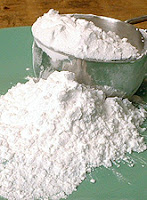Tapioca and It's Production - Tapioca is basically a root starch derived from the cassava, or yuca plant. It's often used to thicken soups and sweeten the flavor of baked goods, and it makes a dandy pudding. The cassava plant is native to South America and the West Indies, where its thick, fibrous roots are used in a variety of forms: bread flour, laundry starch, an alcoholic brew, and of course, tapioca pudding. As the Encyclopedia Britannica tells us, it was probably first harvested by the Mayans.
Tapioca is a starch extracted from the root of the plant species Manihot esculenta. This species, native to the Amazon, Brazil, Colombia and Venezuela as well as the Caribbean, Cuba, Puerto Rico, Haiti, the Dominican Republic, Honduras, most of the West Indies, is now cultivated worldwide and has many names, including cassava, bitter-cassava, manioc, "mandioca", "aipim", "macaxeira", "manioca", "boba", "yuca" (not to be confused with yucca). In India it has different names in different regions such as, "Sagudana" (literally, Sagu drops), "Sabudana"(literally, drops of soap) and "Kappa". In Vietnam, it is called bột năng. In Indonesia, it is called by malay ubi kayu or singkong.In Philippines, it is called sago.
The name tapioca is derived from the word tipi'óka, the name for this starch in Tupi. This Tupi word refers to the process by which the starch is made edible. However, as the word moved out of Brazil it came to refer to similar preparations made with other esculents.
Tapioca is a staple food in some regions and is used worldwide as a thickening agent, mainly in foods. Tapioca is gluten free, and almost completely protein free. 'Tapioca' in Britain often refers to a milk pudding thickened with arrowroot, while in Asia the sap of the Sago palm is often part of its preparation.
The cassava plant has either red or green branches with blue spindles on them. The toxin found in the root of the red-branched variant is less harmful to humans than the green-branched variety. Therefore, while the root of the red/purple-branched variant can be consumed directly, the root of the green-branched variant requires treatment to remove the toxin. Konzo (also called mantakassa) is a paralytic disease associated with several weeks of almost exclusive consumption of insufficiently processed bitter cassava.
Commercially, the starch is processed into several forms: powder, fine or coarse flakes or meal, rectangular sticks, and spherical "pearls". Pearls are the most widely available shape; sizes range from about 1mm to 8mm in diameter, with 2–3mm being the most common.
Flakes, sticks, and pearls must be soaked well before cooking, to rehydrate them; they will easily absorb water equal to twice their volume, becoming leathery and swollen. All these products traditionally are white, but sticks and pearls may be colored. The oldest and most common color is brown, but pastel colors are now available. In all its forms tapioca starch is opaque before cooking; and become translucent when cooked.
Nigeria, Brazil, and Thailand are the world's largest producers of cassava. Thailand accounts for 60% of worldwide exports.
Related Posts:
Related Posts:


No comments:
Post a Comment